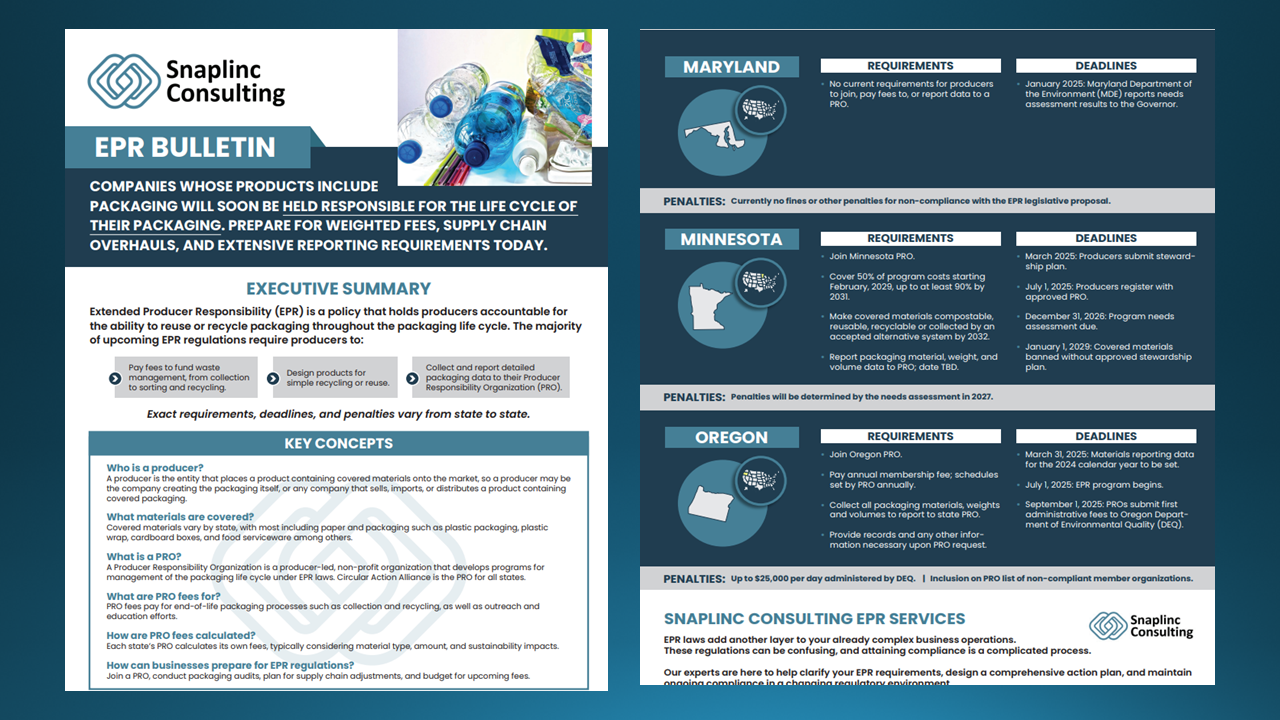Navigating Canada's PFAS Regulations
Executive Summary
Per- and polyfluoroalkyl substances (PFAS) are subject to stringent regulation in Canada due to their persistence, environmental risks, and potential health impacts. Most notably, the Canadian Environmental Protection Act (CEPA) Section 71 requires PFAS reporting by January 29, 2025. Snaplinc Consulting offers a comprehensive overview of Canada’s PFAS regulatory landscape, including mandatory reporting deadlines, key requirements, and actionable strategies for compliance.
What Companies Are Subject to Canada PFAS Reporting?
The Section 71 Notice requires reporting on the manufacture, import, and use of 312 PFAS during the 2023 calendar year. If your brand manufactured, imported, and/or used certain PFAS described in Schedule 1, you are subject to the Notice. Examples of affected parties include those who:
Manufactured a quantity greater than 1 kg of a substance listed in Schedule 1
Imported a quantity greater than 10 grams of a substance listed in Part 1 of Schedule 1, whether alone, in a mixture, or in a product at a concentration equal to or above 1 ppm
A full list of affected entities is outlined here.
2025 Canada PFAS Reporting Requirements
The Notice under CEPA requires reporting on the manufacture, import, and use of 312 PFAS during the 2023 calendar year. Data on PFAS usage across the supply chain must be submitted via a provided Excel template by January 29, 2025 and yearly thereafter. The breadth of the data collection is vast; companies must engage suppliers, track imported goods, and more.
Key PFAS Deadlines and Extensions
The deadline to comply with Canada’s Section 71 Notice is January 29, 2025. Extensions are possible: Companies may request an extension if necessary, but requests should be submitted at least five business days before the deadline. A request for an extension of time submitted after the deadline of January 29, 2025, will not be granted.
Penalties for Noncompliance
Entities that fail to report by the deadline may face financial, reputational, or administrative penalties.
Financial penalty amounts are not yet stipulated in the Notice, but overarching CEPA allows for penalties up to CAD $1 million per violation for individuals and businesses, depending on the severity of the infraction. In addition, environmental enforcement actions can be levied against individuals and corporations.
Reputational damage is also possible, as the ECCC maintains a public record of non-compliant entities. This can harm a company's reputation and break consumer trust, particularly for businesses marketing themselves as environmentally responsible. Non-compliance can signal a lack of commitment to sustainability, leading to negative consumer perception.
Compliance Recommendations
Snaplinc Consulting recommends two courses of action: one to address the immediate deadline, and one to strategize for future PFAS legislation. Immediate to-do items include:
Collecting data and engaging suppliers now to meet annual deadlines
Training your team on PFAS regulatory requirements and reporting processes
Long-term, your firm will need to:
Transition to PFAS-free alternatives where feasible
Maintain open communication with suppliers to ensure transparency
Monitor regulatory developments, as the likelihood of additional substances being added to Schedule 1 under CEPA is high.
Resources and References
Government of Canada’s Guide: ECCC PFAS Guidance Manual
Single Window System: Reporting platform for submission
Industry Associations: Updates on emerging regulations and best practices by industry
Meet with Snaplinc Consulting: Let Snaplinc streamline the entire compliance process.
From accurately assessing supply chains and identifying PFAS in materials to preparing detailed reports required under the Section 71 Notice, we provide expertise and resources for confident compliance to position your firm as an industry leader in environmental responsibility.
Partnering with Snaplinc eliminates guesswork, reduces administrative burdens, and ensures peace of mind, allowing your team to focus on core business operations.
Conclusion
Canada’s evolving PFAS regulations present time-sensitive compliance challenges—and opportunities for proactive companies to demonstrate leadership in sustainability. By adhering to the January 29, 2025 reporting deadline and preparing for future regulatory changes, your company can mitigate risks and strengthen its compliance framework.


